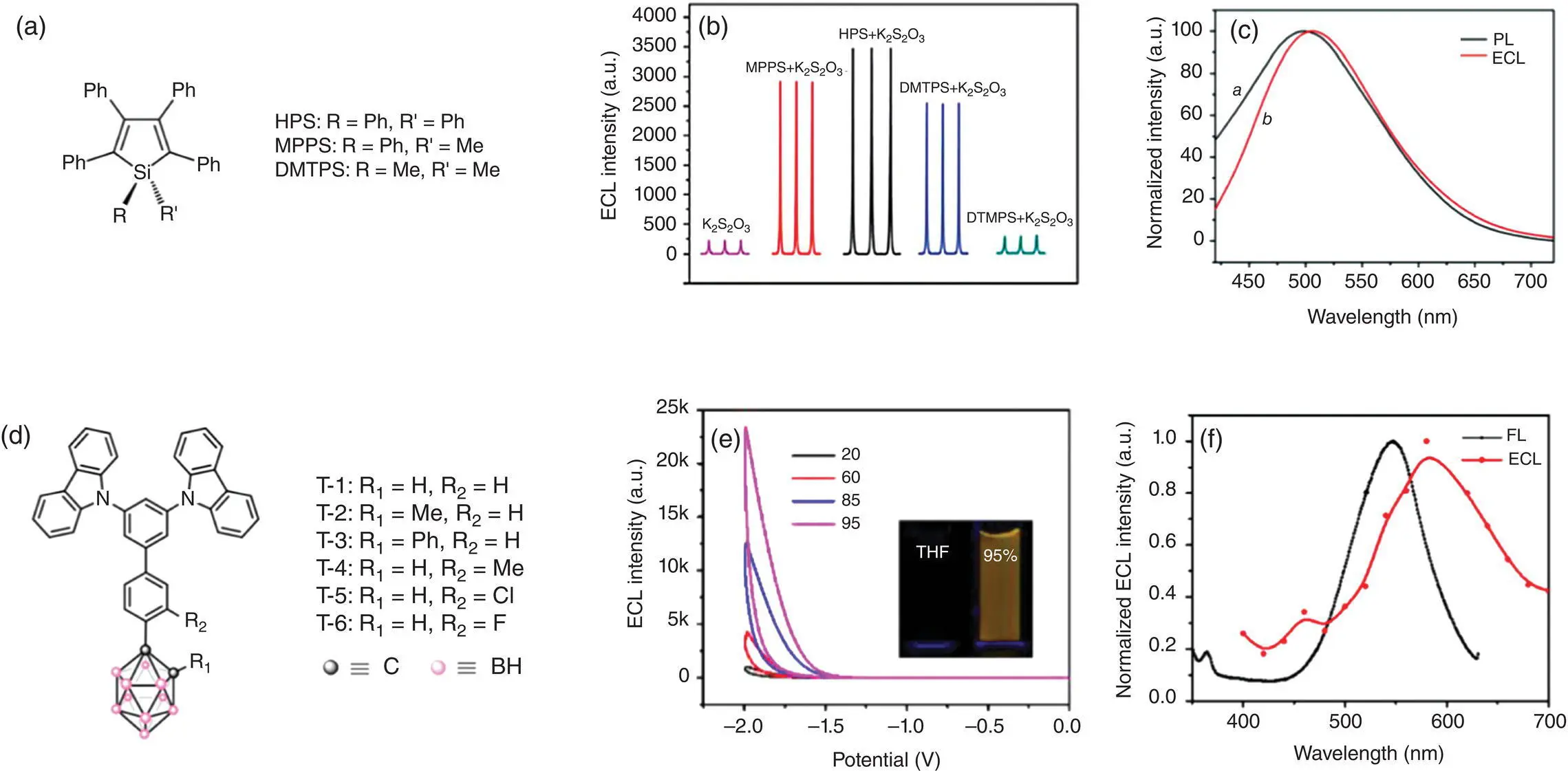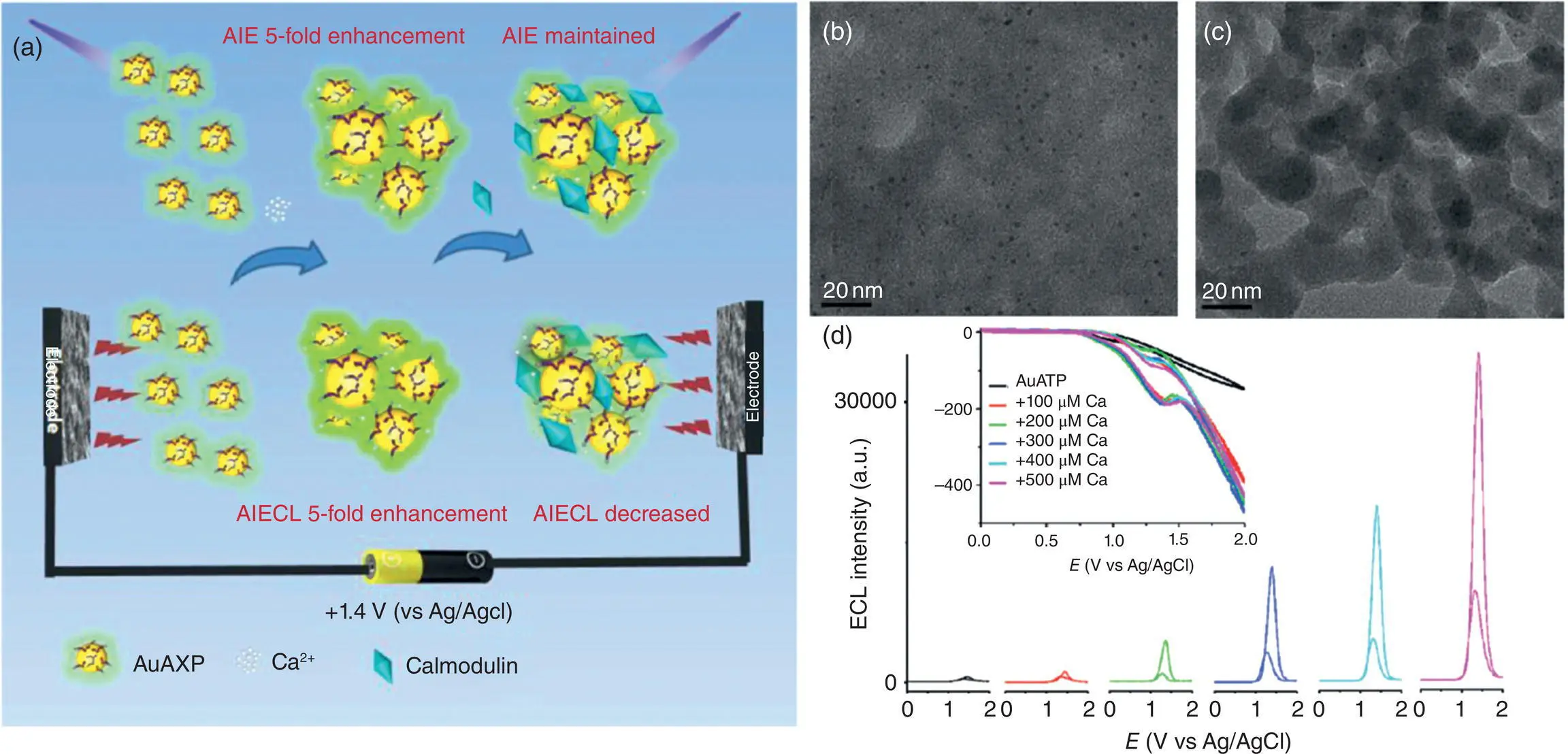Very recently, TPE was integrated into a conjugated microporous polymer (CMP) by Zhang and co‐workers to give 1,1,2,2‐tetrakis(4‐bromophenyl)ethane (TBPE‐CMP) derivatives (1, 2, and 3) [84]. The structure is surrounded by four phenyl rings, which are highly twisted because of the strong hindrance via the rotatable C–C single bond. This leads to a 3D charge‐transporting network that facilitates hole transport [85]. Through DFT calculation, positions of HOMO and LUMO were evaluated to lay onto the tris(4‐ethynylphenyl)‐amine (TEPA) and TBPE, respectively. Coreactant TPrA mechanism was evaluated by potentiodynamic measurements in solid‐state onto GC electrode, showing the best result for TBPE‐CMP 1 at +1.35 V comparing with the other two polymers. It also shows good reproducibility for 27 consecutive cycles with a standard deviation of 1.15%. The ECL spectrum at 627 nm results in a redshift of 67 nm compared with its PL spectrum at 560 nm and it reflects the intrinsically different electron‐hopping pathway between them. The deprotonated intermediated of TPrA can supply the conversion from the oxidized CMP to its excited state at a relatively lower refined oscillatory level than the normal LUMO of TBPE. They further demonstrated the construction of an ECL sensor for the detection of dopamine, which can quench the emission of TBPE‐CMP 1.
Lu and co‐workers focused their investigation on another class of AIE luminophores based on 1,1‐distributed 2,3,4,5‐tetraphenylsiloles, which emit AI‐ECL by a coreactant approach. Siloles (see Figure 4.8a) show unique chemical and optical properties for their low‐lying LUMO levels because of the electronic interaction between the π * orbital of the butadiene moiety and the σ * orbital of the exocyclic Si‐R bond[86]. Their properties as AIE luminophores were then discovered by Tang and co‐workers and studied intensively [82]. However, few attempts of using it as ECL emitters have brought poor results [67, 87, 88], since they have not considered their important properties in aggregated form. Three siloles were synthesized in an easy way, such as 1,1′‐dimethyl‐2,3,4,5‐tetraphenylsilole (DMTPS), 1‐methyl‐1,2,3,4,5‐pentaphenylsilole (MPPS), and 1,1,2,3,4,5‐hexaphenylsilole (HPS), resulting simple structure, nontoxic, and stable. They show the typical characteristics of an AIE luminophore, weak emitter in solution but strongly fluorescent in aggregated form. Coreactant approach has been selected rather than annihilation because of the inefficiency of the latter. Results showed excellent cathodic ECL emission by using K 2S 2O 8. Also, the findings indicated that siloles are superior for forming good aggregates onto GC electrode surface, since there is an interaction between the silicon atoms and the oxygen functional groups on the electrode. The results show an influence of the substituents in position 1,1 with an intensity order DMTPS < MPPS < HPS. The 1,1‐position effectively enhance higher σ *– π * conjugation interactions between exocyclic carbon atoms and endocyclic silicon atom. Additionally, larger substituents also restrict the rotation of the phenyl groups at the silole ring, reducing energy loss and increasing the ECL efficiency. They demonstrate the aggregation effectively reduces the nonradiative energy decay by suppressing intramolecular motions and are largely responsible for the generation of such high ECL emissions, comparing to the dissolved molecule in organic systems. At last, ECL and PL profiles suggest that the excited state is the same for photoexcitation and electrochemical excitation ( Figure 4.8c).

Figure 4.8 (a) Molecular structure of 1,1‐disubstituted 2,3,4,5‐tetraphenylsiloles; (b) ECL intensities versus different siloles/K 2S 2O 8systems: siloles in the aggregated state modified at the electrode surface; (c) PL and ECL normalized spectra of HPS in solid‐state; (d) Molecular structure of carboranyl carbazoles; (e) ECL intensity of 1 mM T‐3 in 20, 60, 85 and 95% H 2O with 10 mM tetraoctylammonium bromide‐modified GC electrode. PMT: 800 V. Inset: 1 × 10 −5M T‐3 in pure THF and 95% H 2O; (f) ECL (red trace) and PL (black trace) emission spectra of 1 × 10 −5M T‐3 in 95% H 2O modified GC electrode.
Source: Readapted from Refs. [51, 89].
A series of boron clusters using carbazolyl and carboranyl moieties as electron donor and acceptor, respectively, have been explored as well as reductive‐oxidative ECL by Xu and co‐workers [89]. They were the first to deal with AI‐ECL properties of these unique aggregated organic dots in aqueous media, although extensive studies on carborane‐based aggregation‐induced PL molecules or assemblies have been reported [90, 91]. All the synthesized compounds displayed AI‐ECL in solid‐state onto a GC electrode starting from a solution of clusters obtained in a mixture 5/95 THF/H 2O. The results show a notable increase compared to the molecule dispersed in THF. The compound T‐3 was investigated in detail for PL and ECL properties in different water fractions. From the emission spectra, it is clear that ECL excited state might be generated from surface state transition, and therefore its result differ from the PL one. This study opened the way for further studies in the reductive‐oxidative ECL pathway which is still in its infancy.
4.2.4 Hybrid and Functional Materials
AI‐ECL of functional hydrogels formed by gold nanoclusters (Au‐NC) linked with bivalent cations such as Ca 2+was reported for the first time by Wang and coworkers ( Figure 4.9) [92]. TEM studies revealed that the formed hydrogel has a hydroxyl apatite like structure because of coexistence of calcium, hydroxyl groups from ribose and phosphates group. The nanoclusters showed to be sensitive to bivalent cations, when they are coated with adenosine phosphates (mono‐, di‐, and tri‐), demonstrating that the interaction between these cations and phosphate groups increases the PL for AIE effect. This interaction reduces the nonradiative relaxation of excited states by restricting the intramolecular vibration and rotation of capping ligands and induces a significant emission enhancement. Together with PL, their ECL emission enhancement was observed and examined. The ECL increased significantly during anodic scan in 2‐[4‐(2‐hydroxyethyl)‐1‐piperazinyl]ethanesulfonic acid (HEPES, pH 7.0) upon addition of TEA as coreactant. The peak intensity revealed a 50‐fold enhancement comparing to the AuATP NCs alone without Ca 2+( Figure 4.9d). The enhancement was found much higher than the PL, attributing to this improved signal, a better adsorption of the hydrogel to the electrode surface than ultrasmall NCs, as TEM showed ( Figures 4.9b–c). Thanks to the great enhancement by ECL, this hydrogel was used to build a sensor platform for Calmodulin, which is a binding protein of Ca 2+and it may sense it selectively by affecting the AI‐ECL emission. On the basis of the binding power, the ECL decreased with increasing concentration of Calmodulin in the range 0.3–50 μg/ml. Then, this biomacromolecule‐responsive AI‐ECL type hydrogel may be potentially use for the design of bivalent metal ions relevant to biological events like in neurosignal transportation in synapse, chloroplast, and zin‐finger motif.

Figure 4.9 (a) Illustration of bivalent cations induced aggregation of NCs with CaM regulated ECL; (b–c) TEM images of AuATP NCs before and after addition of Ca 2+; (d) Potential‐dependent ECL emission by AuATP NCs of 0.1 mg/ml and different concentration of Ca 2+(from left to right: 0, 100, 200, 300, 400, and 500 × 10 −6M) using cyclic voltammetry scans. Inset: the corresponding cyclic voltammetry curves.
Читать дальше














